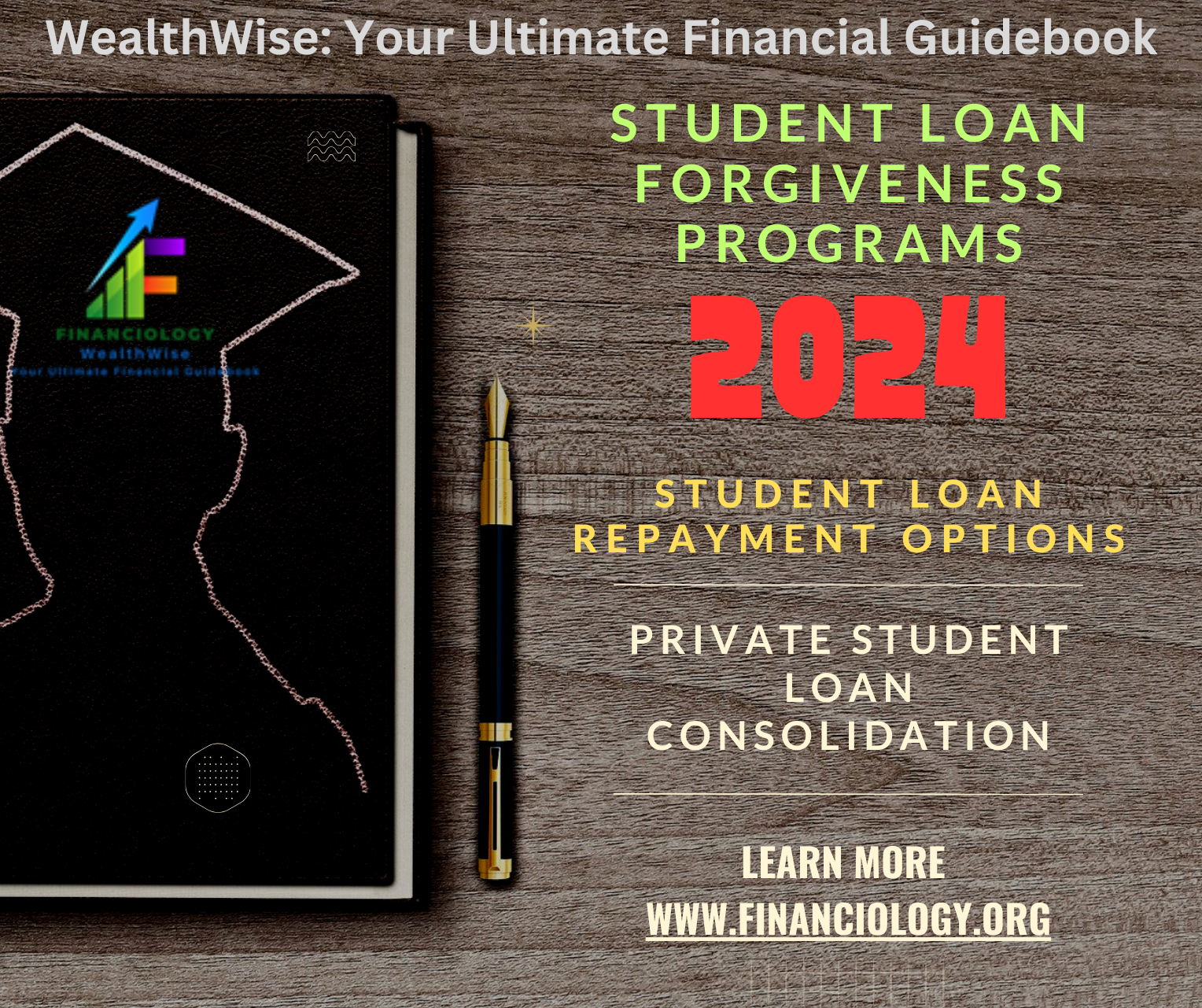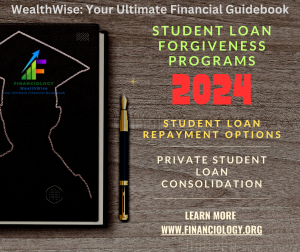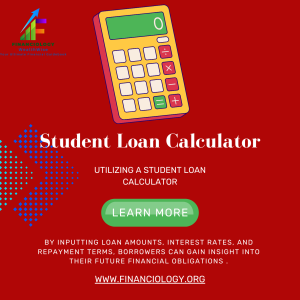Discover Student Loan Forgiveness Programs in 2024
7 min read
Student loan forgiveness programs
Navigating Student Loan Forgiveness Programs:
Discover the Best Student Loan Forgiveness Programs to Ease Your Financial Burden A Lifeline for Borrowers:
Explore the world of student loan forgiveness programs and find relief from your educational debt. Learn about various options and eligibility criteria to make an informed decision.
In today’s ever-evolving educational landscape, pursuing higher education often comes with a hefty price tag attached – student loans. While these loans are instrumental in allowing students to access education, they can also become a significant financial burden post-graduation. However, there is a glimmer of hope for borrowers in the form of student loan forgiveness programs.
Understanding Student Loan Forgiveness Programs
Student loan forgiveness programs are initiatives designed to alleviate the financial strain on borrowers by forgiving a portion or all of their outstanding student loan debt. These programs are typically available to individuals who meet specific eligibility criteria, which may include working in certain professions, serving in public service roles, or making consistent payments for a designated period.
Exploring Available Options
There are several student loan forgiveness programs available, each catering to different circumstances and career paths. One prominent example is the Public Service Loan Forgiveness (PSLF) program, which forgives the remaining balance on Direct Loans after the borrower has made 120 qualifying monthly payments while working full-time for a qualifying employer.
Another option is the Teacher Loan Forgiveness program, aimed at educators working in low-income schools or educational service agencies. Qualified teachers may be eligible for forgiveness of up to $17,500 on Direct Subsidized and Unsubsidized Loans and Subsidized and Unsubsidized Federal Stafford Loans.
For those in the healthcare field, programs such as the National Health Service Corps (NHSC) Loan Repayment Program offer loan repayment assistance to primary care medical, dental, and mental/behavioral health clinicians who serve in Health Professional Shortage Areas.
Navigating Eligibility Requirements
While the prospect of student loan forgiveness is undoubtedly appealing, it’s essential to understand the eligibility requirements for each program. Eligibility criteria may vary widely, ranging from specific employment conditions to the type of loans eligible for forgiveness.
Additionally, maintaining compliance with program requirements, such as making timely payments and meeting service obligations, is crucial to ensure eligibility for forgiveness.
Making Informed Decisions
Before diving into any student loan forgiveness program, borrowers should conduct thorough research and carefully evaluate their options. Understanding the terms, conditions, and potential benefits of each program is essential for making informed decisions that align with their financial goals and career aspirations.
Furthermore, seeking guidance from financial advisors or loan servicers can provide invaluable assistance in navigating the complex landscape of student loan forgiveness programs. These professionals can offer personalized advice based on individual circumstances and help borrowers develop strategies to manage their student loan debt effectively.
Student loan forgiveness programs serve as a beacon of hope for borrowers grappling with the burden of educational debt. By exploring available options, understanding eligibility requirements, and making informed decisions, borrowers can take proactive steps toward achieving financial freedom and pursuing their professional aspirations without being weighed down by student loans.
Exploring Student Loan Repayment Options

A Comprehensive Guide for Borrowers:
Unveiling the best student loan repayment options to manage your debt: Dive into the realm of student loan repayment options and discover effective strategies to tackle your educational debt. Explore various repayment plans and assistance programs tailored to your financial needs.
In higher education, student loans often serve as a necessary means to access academic pursuits. However, once graduation arrives, the looming reality of repayment can cast a shadow on post-graduate plans. Fortunately, many student loan repayment options exist to help borrowers navigate this financial journey.
Understanding Student Loan Repayment Options
Student loan repayment options encompass a range of plans and programs designed to assist borrowers in managing their educational debt. From standard repayment plans to income-driven options, these avenues offer flexibility and relief to individuals facing repayment challenges.
Exploring Repayment Plans
One of the most common repayment options is the Standard Repayment Plan, which entails fixed monthly payments over a set period, typically ten years. While this plan provides a straightforward approach to repayment, borrowers may find themselves seeking more flexibility based on their financial circumstances.
Income-driven repayment Plans, such as Income-Based Repayment (IBR), Pay As You Earn (PAYE), and Revised Pay As You Earn (REPAYE), offer relief by adjusting monthly payments based on income and family size. These plans can be particularly beneficial for borrowers with fluctuating incomes or substantial debt burdens.
Additionally, Graduated Repayment Plans gradually increase monthly payments over time, making them ideal for borrowers expecting income growth in the future. Extended Repayment Plans extend the repayment period beyond the standard ten years, resulting in lower monthly payments but potentially higher total interest costs.
Navigating Assistance Programs
In addition to repayment plans, various assistance programs exist to support borrowers in managing their student loan debt. For example, the Public Service Loan Forgiveness (PSLF) program forgives remaining loan balances for individuals working full-time in qualifying public service positions after making 120 qualifying payments.
Furthermore, student loan consolidation programs, such as Direct Consolidation Loans, allow borrowers to combine multiple federal student loans into a single loan with a fixed interest rate. This simplifies repayment by consolidating multiple payments into one and may even lower monthly payments through extended repayment terms.
Choosing the Right Option
Selecting the most suitable student loan repayment option requires careful consideration of individual financial circumstances and long-term goals. Borrowers should assess factors such as income stability, career trajectory, and family obligations when determining which plan or program best aligns with their needs.
Moreover, seeking guidance from financial advisors or loan servicers can provide valuable insights and assistance in navigating the complexities of student loan repayment. These professionals can offer personalized advice and help borrowers develop strategies to effectively manage their educational debt.
Student loan repayment options offer a lifeline for borrowers grappling with the challenges of post-graduate debt. By exploring available plans and assistance programs, understanding eligibility criteria, and seeking guidance when needed, borrowers can take proactive steps toward achieving financial stability and securing a brighter financial future.
Related blogs:
- Explore the Best Student Loans in California
- Understanding the Types of Student Loans
- Best Student Loan Consolidation
- Student Loan Forgiveness Plans
- Sofi Student Loan Refinancing
The Benefits of Private Student Loan Consolidation
Unlock financial freedom with private student loan consolidation: Everything you need to know to streamline your finances: Discover the advantages of private student loan consolidation and streamline your finances. Learn about the process, benefits, and considerations to make an informed decision about managing your educational debt.
As graduates embark on their professional journeys, the weight of student loan debt can often overshadow their financial plans. Private student loan consolidation emerges as a strategic solution to simplify repayment and potentially save money in the long run.
Understanding Private Student Loan Consolidation
Private student loan consolidation involves combining multiple private student loans into a single loan with a new interest rate and repayment terms. Unlike a federal loan consolidation, which merges federal loans under a Direct Consolidation Loan, private consolidation applies to loans obtained from private lenders.
Exploring the Benefits
Consolidating private student loans offers several benefits to borrowers seeking financial relief:
- Simplified Repayment: By consolidating multiple loans into one, borrowers can streamline their monthly payments, making it easier to manage finances and avoid missed payments.
- Lower Interest Rates: Depending on current market conditions and creditworthiness, borrowers may qualify for a lower interest rate through consolidation, resulting in potential savings over the life of the loan.
- Flexible Repayment Terms: Private consolidation allows borrowers to choose repayment terms that align with their financial goals, such as extending the repayment period to reduce monthly payments or opting for a shorter term to pay off the loan faster.
- Improved Credit Score: Consolidating multiple loans into a single account can positively impact credit scores by reducing the number of active accounts and potentially lowering overall credit utilization ratios.
Navigating the Consolidation Process
The process of private student loan consolidation typically involves the following steps:
- Gather Information: Collect details about each existing loan, including lender names, account numbers, outstanding balances, and interest rates.
- Research Lenders: Explore reputable lenders offering private consolidation loans and compare their terms, interest rates, and eligibility requirements.
- Submit an Application: Apply for consolidation with the chosen lender, providing necessary documentation and consenting to a credit check.
- Review Terms: Once approved, carefully review the terms of the new consolidation loan, including interest rates, repayment options, and any associated fees.
- Accept Offer: If satisfied with the terms, accept the consolidation loan offer and proceed with closing the existing loans.
Considering Important Factors
Before opting for private student loan consolidation, borrowers should consider the following factors:
- Interest Rates: Assess whether the new interest rate offered through consolidation is lower than the combined rates of existing loans.
- Fees: Be mindful of any origination fees, prepayment penalties, or other charges associated with the consolidation loan.
- Repayment Terms: Evaluate the impact of extending or shortening the repayment period on monthly payments and total interest costs.
- Creditworthiness: Understand that approval for consolidation and the terms offered may depend on credit history and financial stability.
Making Informed Decisions
Private student loan consolidation presents an opportunity for borrowers to take control of their finances and simplify the repayment process. By weighing the benefits, navigating the consolidation process diligently, and considering important factors, borrowers can make informed decisions that align with their long-term financial goals.
Useful Student Loan Providers Online Links:
Nelnet Student Loan Servicing: Click here
Sallie Mae Education Loan: Click here
Sofi Private Student Loan: Click here
We will discuss federal student loan interest rates, student loan deferment qualifications, and student loan default consequences, in our next blog. Please give feedback about this blog if this is helpful or needs improvement, we’ll appreciate your valuable comments.






